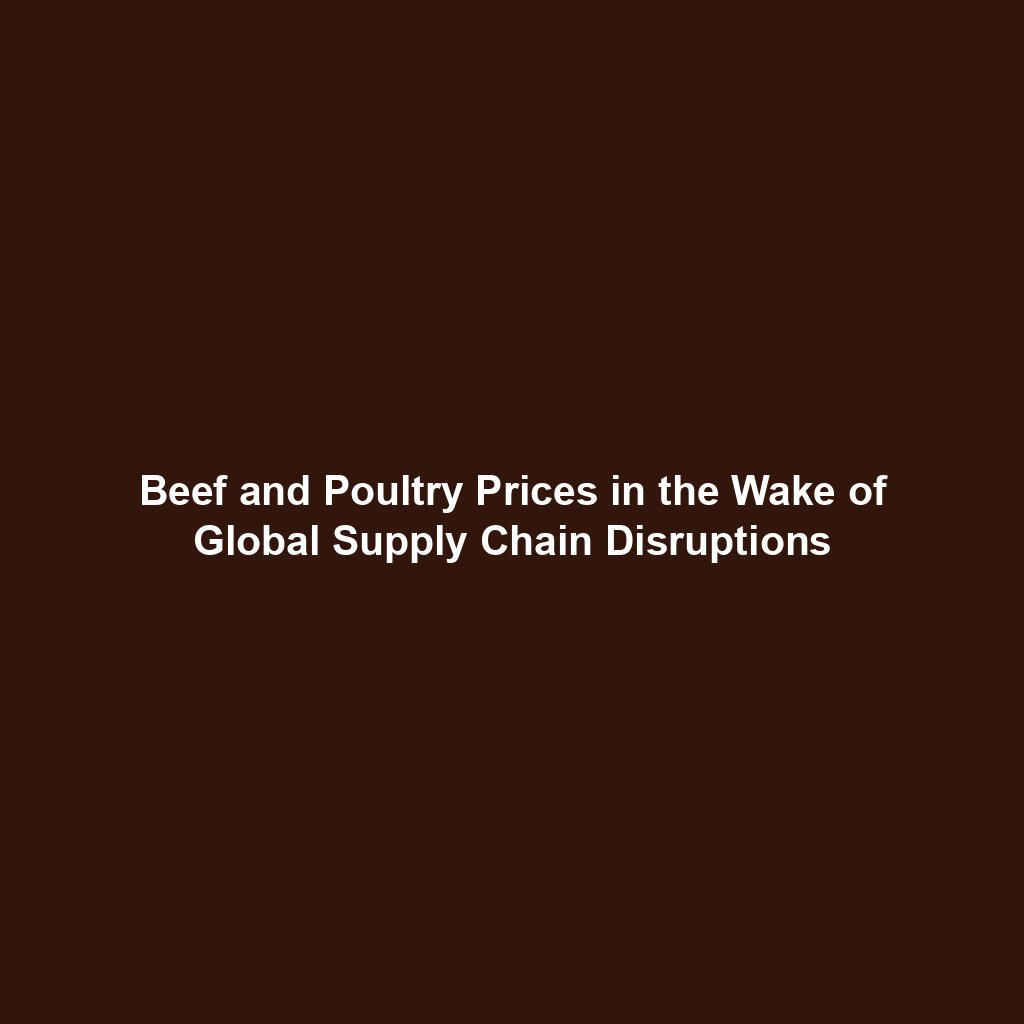
Agriculture and agricultural price analysis are critical components of understanding the economic landscape, especially in the context of global supply chain disruptions. This article delves into the intricacies of beef and poultry prices, examining how recent global events have impacted these essential commodities. By exploring the factors influencing price fluctuations and the broader implications for consumers and producers, we aim to provide a comprehensive overview of the current state of the market.
Chapter 1: The Impact of Global Supply Chain Disruptions on Beef Prices
1.1 Overview of the Beef Industry
The beef industry is a cornerstone of the global agricultural sector, providing a significant source of protein for millions of people worldwide. The industry encompasses various stages, from cattle farming and feed production to processing and distribution. Each stage is interconnected, and disruptions in one area can have cascading effects throughout the supply chain.
1.2 Factors Contributing to Supply Chain Disruptions
Several factors have contributed to recent supply chain disruptions in the beef industry. These include:
- COVID-19 Pandemic: The pandemic has caused labor shortages, transportation delays, and increased health and safety regulations, all of which have disrupted the normal flow of goods.
- Climate Change: Extreme weather events, such as droughts and floods, have affected cattle feed production and availability, leading to increased costs and reduced supply.
- Trade Policies: Changes in trade policies, tariffs, and export restrictions have also played a role in disrupting the global beef supply chain.
1.3 Price Fluctuations and Their Causes
The disruptions mentioned above have led to significant price fluctuations in the beef market. For instance, labor shortages in processing plants have reduced production capacity, leading to a decrease in supply and an increase in prices. Additionally, transportation delays have caused bottlenecks, further exacerbating supply issues.
Climate change has also played a crucial role. Droughts have reduced the availability of feed, increasing costs for farmers and, consequently, the price of beef. Trade policies, such as tariffs on imported beef, have added another layer of complexity, affecting both supply and demand dynamics.
1.4 Broader Implications for Consumers and Producers
The price fluctuations in the beef market have far-reaching implications for both consumers and producers. For consumers, higher beef prices can lead to increased food costs, affecting household budgets and potentially leading to changes in dietary habits. For producers, the increased costs of feed and labor can squeeze profit margins, making it more challenging to sustain operations.
Moreover, the uncertainty in the market can lead to volatility, making it difficult for both consumers and producers to plan for the future. This volatility can also impact related industries, such as restaurants and food retailers, further amplifying the economic effects.
Chapter 2: The Impact of Global Supply Chain Disruptions on Poultry Prices
2.1 Overview of the Poultry Industry
The poultry industry is another vital component of the global agricultural sector, providing a more affordable source of protein compared to beef. The industry includes various stages, from breeding and feed production to processing and distribution. Like the beef industry, the poultry supply chain is highly interconnected, and disruptions can have significant ripple effects.
2.2 Factors Contributing to Supply Chain Disruptions
The poultry industry has faced similar supply chain disruptions as the beef industry, including:
- COVID-19 Pandemic: Labor shortages, transportation delays, and increased health and safety regulations have disrupted the normal flow of goods in the poultry industry.
- Avian Influenza: Outbreaks of avian influenza have led to the culling of millions of birds, reducing supply and increasing prices.
- Feed Costs: The cost of feed, which constitutes a significant portion of poultry production costs, has increased due to climate change and other factors.
2.3 Price Fluctuations and Their Causes
The disruptions in the poultry supply chain have led to notable price fluctuations. Labor shortages in processing plants have reduced production capacity, leading to a decrease in supply and an increase in prices. Transportation delays have caused bottlenecks, further exacerbating supply issues.
Outbreaks of avian influenza have had a particularly severe impact on the poultry industry. The culling of infected birds has reduced supply, leading to higher prices. Additionally, the increased cost of feed has put upward pressure on prices, as farmers pass on these costs to consumers.
2.4 Broader Implications for Consumers and Producers
The price fluctuations in the poultry market have significant implications for both consumers and producers. For consumers, higher poultry prices can lead to increased food costs, affecting household budgets and potentially leading to changes in dietary habits. For producers, the increased costs of feed and labor can squeeze profit margins, making it more challenging to sustain operations.
Moreover, the uncertainty in the market can lead to volatility, making it difficult for both consumers and producers to plan for the future. This volatility can also impact related industries, such as restaurants and food retailers, further amplifying the economic effects.
Conclusion
The global supply chain disruptions have had profound effects on both the beef and poultry industries, leading to significant price fluctuations and broader economic implications. Understanding the factors contributing to these disruptions and their impact on prices is crucial for consumers, producers, and policymakers. By addressing the underlying issues, such as labor shortages, climate change, and trade policies, stakeholders can work towards creating a more resilient and stable agricultural sector.
In summary, the current state of the beef and poultry markets highlights the interconnectedness of global supply chains and the importance of addressing the root causes of disruptions. By doing so, we can ensure a more stable and sustainable future for the agricultural sector and the millions of people who depend on it for their livelihoods and nutrition.



